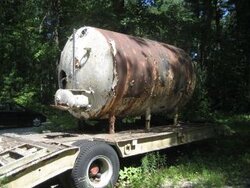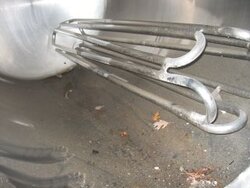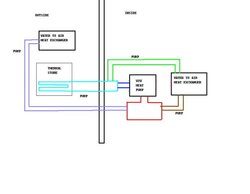I am looking at storing cold in my thermal store and using it for air conditioning. I am looking for recommendations.
I have a Tarm pressurized system in an outside storage unit. This runs a heat exchanger loop into an unpressurized 1500 gallon insulated milk tank. There is another loop for heat(forced air) and DWH.
I currently use 2 window airconditioners during the summer. They run continuously during the day. I’m guessing that they are about 20K BTU’s total (about 1.5 tons). If I find a water-to-water heat pump, I can run the hot side through my DWH superstore, continuing outside to the boiler loop(boiler off). This would heat my water and dump excess heat outside. The cold side would be put through the heat exchangers in the 1500 gallon tank. I will be running Propylene Glycol in the system and would like to get down to 25F or so on the cold side.
The cooler temperatures in the evening with some radiational cooling will allow me to harvest the cold “off peak”. During the daytime, I would pump the cool out through a heat exchanger into the forced air system. It would be sweet to add off peak electric rates for this if I can get them.
I would also like to swap the hot/ cold loop and heat the tank with the daytime temps during spring and fall for use during the colder evenings.
Does anyone know of a water to water heat pump in the 1 - 1 1/2 ton(12K - 18K BTU’s) range?
Also, I was wondering what the best coil arrangement would be for this water cooled “chiller”. I currently have a hot water coil in the up flow furnace plenum for heating. I may want to find a chiller to put in above the current coil. This would have the cold added at the top, flowing downwards, possibly plumbing the hot water coil in also.
I don’t know how to add the condensate drain pan under the coils in the up flow. It seems like the pan would block the air.
Another concept would be to buy a downflow or side flow heat exchanger and place it before the furnace. This could have the drain pan on the side of the furnace. I could plumb the hot water coil, but it would be last in the cooled water loop to avoid condensation on it.
I would really like to have the first solution (all coils in the furnace plenum). This would be the same plumbing for heating and cooling. Also with the extra cold water coil, I could get more heat out of it during the winter.
All of my coils/plumbing is 1” PEX. My Tarm boiler is in a storage container. I am considering adding a solar exhanger to the side of the container. This would add to my daytime heat gain for hot storage, and the radiational cooling during the cold storage season.
This is really just a geothermal heatpump, but only using the diurnal ranges for short term storage.
Thanks
Carl
I have a Tarm pressurized system in an outside storage unit. This runs a heat exchanger loop into an unpressurized 1500 gallon insulated milk tank. There is another loop for heat(forced air) and DWH.
I currently use 2 window airconditioners during the summer. They run continuously during the day. I’m guessing that they are about 20K BTU’s total (about 1.5 tons). If I find a water-to-water heat pump, I can run the hot side through my DWH superstore, continuing outside to the boiler loop(boiler off). This would heat my water and dump excess heat outside. The cold side would be put through the heat exchangers in the 1500 gallon tank. I will be running Propylene Glycol in the system and would like to get down to 25F or so on the cold side.
The cooler temperatures in the evening with some radiational cooling will allow me to harvest the cold “off peak”. During the daytime, I would pump the cool out through a heat exchanger into the forced air system. It would be sweet to add off peak electric rates for this if I can get them.
I would also like to swap the hot/ cold loop and heat the tank with the daytime temps during spring and fall for use during the colder evenings.
Does anyone know of a water to water heat pump in the 1 - 1 1/2 ton(12K - 18K BTU’s) range?
Also, I was wondering what the best coil arrangement would be for this water cooled “chiller”. I currently have a hot water coil in the up flow furnace plenum for heating. I may want to find a chiller to put in above the current coil. This would have the cold added at the top, flowing downwards, possibly plumbing the hot water coil in also.
I don’t know how to add the condensate drain pan under the coils in the up flow. It seems like the pan would block the air.
Another concept would be to buy a downflow or side flow heat exchanger and place it before the furnace. This could have the drain pan on the side of the furnace. I could plumb the hot water coil, but it would be last in the cooled water loop to avoid condensation on it.
I would really like to have the first solution (all coils in the furnace plenum). This would be the same plumbing for heating and cooling. Also with the extra cold water coil, I could get more heat out of it during the winter.
All of my coils/plumbing is 1” PEX. My Tarm boiler is in a storage container. I am considering adding a solar exhanger to the side of the container. This would add to my daytime heat gain for hot storage, and the radiational cooling during the cold storage season.
This is really just a geothermal heatpump, but only using the diurnal ranges for short term storage.
Thanks
Carl




